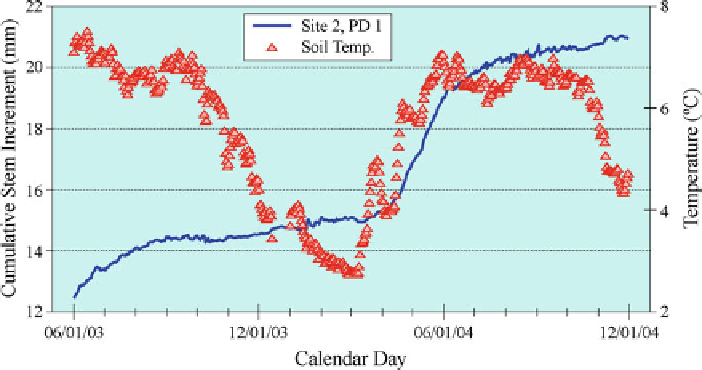Geoscience Reference
In-Depth Information
Fine-scale monitoring of tree growth dynamics is essential to improve our
understanding of the climatic controls that influence both tree-ring mor-
phology and size. Timing of the ring formation can bring clues to improve
interpretation of the tree-ring growth/climate models. In recent years, we set
up monitoring networks to follow tree growth and obtain in situ weather data
from forest ecosystems in Argentina and Mexico. At Cerro Krund, southern
Tierra del Fuego, Argentina, a network of permanent plots was established
along the altitudinal gradient of
Nothofagus pumilio
, from the valley bottom
to the tree line. At a given plot, the initial surge of earlywood occurs after
the first formed leaves are fully expanded; later, the cambium becomes most
active and then finally ceases by producing latewood cells toward the end of
summer. The influence of altitude is expressed in a delay of the onset of the
initial growth stages (up to 2 weeks between lower and higher plots) and in
the shortening of the vegetative growth period. At lower elevations the cam-
bium remains active for 3-4 months, compared to only 2-3 months at the
tree line. Rapid changes in temperature act as the environmental catalyst to
force the changes of the leaf phenological phases and the wood morphologi-
cal changes through the ring. Box Figure
7.17
shows a synchrony between a
sustained increase of the maximum air temperatures to values above a thresh-
old of 10
◦
C and the beginning of the growth phases. Toward the end of austral
summer, trees slowly end their growth cycle as maximum temperatures fall
below this threshold line.
Box Fig. 7.18
Two seasons of growth are shown in the monitored
Pinus hartwegii
stand in southwestern Mexico. Onset of growth is coincident with the increase of spring
temperatures above 3.6ºC. Continuation of growth is dependent on monsoon moisture


